|
|
1973 Datsun-Nissan South Africa brochure (8pp)
Take off in a Datsun 1200 deluxe·GX·GX coupé
datsun 1200 range
(cover)
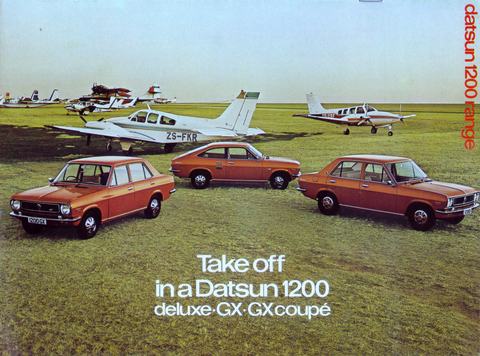
Deluxe
(page 2)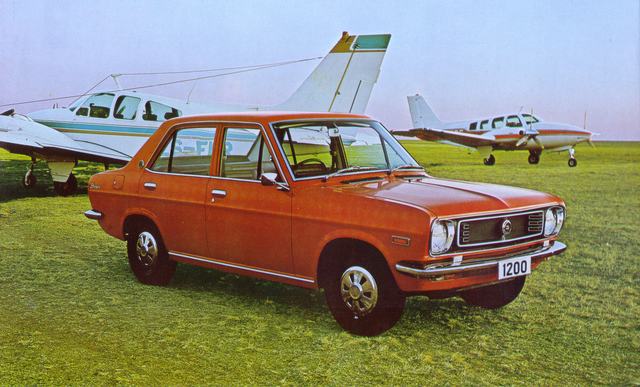 | datsun 1200 deluxe |
|
The original Big Little Car. Everything about it is big — except the price! The Datsun 1200 de luxe is big on power : a potent 69 bhp gives a top speed of over 145 km/h (90 mph). The 1200 is big on room : four doors make getting in and out a lot easier, while doors and windows are curved to provide more interior room. The boot is full family size. The 1200 is big on luxury. Through-flow ventilation. Heater with two-speed fan. Lockable petrol cap. Reclining front seats for long-trip naps.
In fact, the only thing little about the Datsun 1200 is the price. Far less than you'd normally pay for such a combination of features. And, in th elong run, incredibly economical on petrol. | |
|
1200GX
(page 3)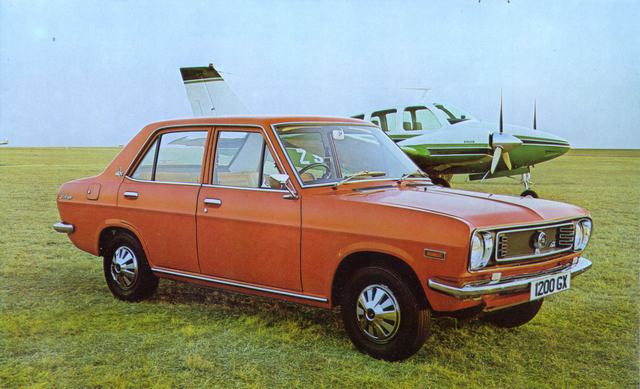 | Datsun 1200GX | | The Datsun 1200 GX takes over where the de luxe leaves off. GX-tra performance from twin carbs gives you a top speed of 160 km/h (100 mph). So you can outpace the big sixes and overtake with confidence. For extra safety, the GX has big disc brakes up front with a dual circuit. Radial-ply tyres are standard. The passenger compartment is rigid, while both the front and rear of the car are progressively crushable to absorb impact. Inside, luxuries abound. There's a console clock with sweep second hand. Through-flow ventilation. A cigarette lighter. Fully reclining seats. A rev counter. And wall-to-wall carpeting. The GX is Datsun's Big Little Car with Something Extra! | |
|
Coupe
(page 4)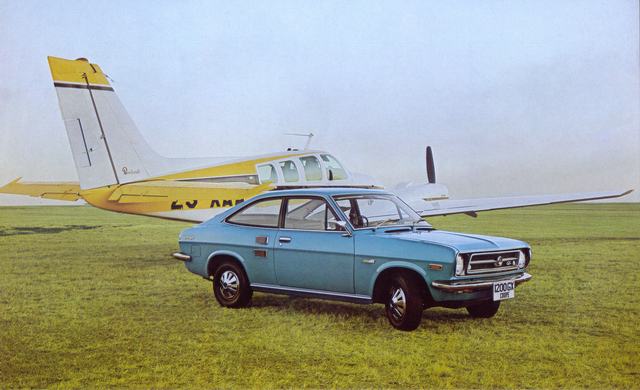 | datsun 1200 GX coupé | | Without a doubt, this is South Africa's most exciting light car. It looks like a luxury import. It goes like a bomb: startling acceleration rockets you to over 160 km/h (100 mph). The interior is almost self-indulgently plush. Console clock with sweep second hand is standard. And, as if this weren't enough, the GX Coupe is also immensely practical — fold down the back seat and you have an instant station wagon. With a low price tag and low running costs, the GX Coupe can offer you many of the benefits of a far bigger car with none of the drawbacks. It's an individual's car, a family car, a carry-all car. So take off ... in a Datsun 1200 GX Coupe. You'll never look back. | |
|
Safety & Reliability
(page 5) |  | |
| datsun 1200's safety
The Nissan Motor Company of Japan has deliberately crashed hundreds of cars as part of its safety research programme. This might, at first, sound like an expensive way of doing things. But it's the only sure way of discovering how to make a car as safe as is humanly possible. As a result of this research, numerous safety features have been incorporated into the Datsun 1200 range — from impact-absorbing body panels and anti-burst door locks to protected petrol tank and superior braking systems. The Datsun 1200 range is the product of one of the world's most safety-conscious car companies.
datsun's rally·reliablity
Datsun-Nissan has a reputation for making cars that have proved themselves in racing and rallying. This involvment in off-the-road activities is valuable for two reasons. It enables Datsun-Nissan to incorporate in production models all sorts of reliability benefits. And it proves to you, the customer, that Datsun can stand up to any amount of pounding you're likely to give it.
For the first time, Datsun-Nissan South Africa entered a Datsun 1200 GX in the 3rd BNU Internation Rally. Driven by Oda Dencker Andersen and Charlotte Heuser, it won both Class B and the Ladies' Prize. You'll never look back. | |
|
BNU Rally Success
BNU RALLY SUCCESS FOR DATSUN 1200 | |
|
OVERSEAS RALLY crews are tending to operate like jockeys more and more these days. They sign to drive a car for one event – then maybe a totally different machine for the next.
Until a couple of years ago a factory-entered car was usually campaigned throughout the season by the same contracted works driver and navigator. They got to know the car and what sort of machinery they were taking on.
Now a driver may rally three or four different makes in as many international events with a different navigator each time.
On the European rally circuit everybody knows everybody and the competing cars. But when a crew is offered a drive in a locally prepared car in a South African international, they are taking on rather an unknown quantity – however good the reputation of the team.
This was just the sort of plunge into the unknown that faced the top European women crew Oda Dencker Andersen of Denmark and her German co-driver Charlotte Heuser when Datsun-Nissan offered them the chance to run a 1200 GX in the testing BNU Rally this June.
After the event – which covered 4 000 km over some of the roughest and tightest roads in South Africa and Mozambique – the petite blonds' verdict was : "This is the best rally car we've ever driven."
That is praise indeed from this experienced pair who added the BNU Ladies' Prize to a long list of successes. It was particularly heartwarming for Datsun-Nissan special vehicle manager Ewold van Bergen and his team because this was their first attempt to take their company's baby car rallying.
When van Bergen invited us to take a look at the car and a test run along the dirt roads around the Rosslyn factory, the only post-rally maintainance it had received was a
|
|
wash and brush up. The undented red bodywork, still resplendent in rally stickers, was unmarked – evidence that it had not given the crew a hairy ride. Without the stickers it would not be the sort of car to draw attention to itself in city traffic. But this belied its exciting performance. I have ridden in many competition cars where conversations become shouting matches to
 Ode and Charlotte after receiving their trophies for winning the Lady's category in the BNU.
Ode and Charlotte after receiving their trophies for winning the Lady's category in the BNU.
combat the harsh roar of the engine and the scream from the transmission.
This was not the case with the 1200. Once strapped into the passenger seat with the full harness beside Van Bergen, it was definitely apparent that this was no ordinary car. The engine was definitely all there - making its presence felt with strong acceleration and a muffled roar which intensified above 3 000 rpm when it "came up on the cams". But normal speech levels were quite effective.
A ride beside a skilled competition driver is always instructive and rarely frightening. This occasion was no exception while Van Bergen ably demonstrated how a powerful car with well set-up suspension can be cornered unreally fast on loose surfaces. A standard car would, under the same conditions, leave the road because it lacks the power needed to control it at high speed.
This ride was more interesting than most because the man responsible for developing the car was taking his first opportunity to drive it hard under competition
|
|
conditions.
His comments gave a good insight into what makes a good rally car.
The girls had thoroughly enjoyed the BNU Rally, and this was easy to understand. The Datsun ran like a train, and was easy to drive. The light steering was an important factor, and Van Bergen announced his satisfaction with the front suspension – only modified by the substitution of gas-filled shock absorber struts for the standard oil variety.
The gas struts stand up much better to the continuous hammering from rapid progress on rough surfaces than the conventional sort which "fade", reducing road holding.
"I'm not a hard suspension fundi," said Van Bergen. "I go for reasonable spring and shock absorber rates which allow the suspension to move with the road surface irregularities. Some people adjust the shock absorbers to their stiffest, and eventually they just get punched through the bodywork."
The rear axle was a bit livelier than he had hoped despite gas struts, and he intends to experiment with this a little before the girls return to drive the car in the Total Rally at the end of August. "But it's unfair,"' said, "to pile a live rear axle car into a bend as fast as you would with independent rear suspension.
Part of the problem is the wheel size which accentuates the leverage under power on the rear leaf springs.
But as Van Bergen put it: "The choice was Hobson's" He ordered special Dunlop "knobbly" radial tyres to fit the standard 12-inch wheels, but only 13-inch tyres were available.
This increase threw other calculations out too. The car was overgeared as a result, but there was no time to try a new rear axle ratio. So the engine never got near its peak 8 000 rev limit in top gear.
| |
BNU Rally
(page 7)

| Ode Denker Anderson and Charlotte Heuser in the DATSUN 1200GX pictured during one of the difficult special stages near the end of the International BNU Rally. | |
|
The five-speed box was developed for racing in Japan. It turned out to be so successful and nice to use that it is now offered as an option on Japanese-built 1200s. And it allowed well spaced ratios on the South African rally car.
The success of the engine modifications gave Van Bergen obvious pleasure. In standard form it is a lively enough performer giving 83 "working" horses, and he is conservative in his estimation of the modified output. "Everybody likes to talk about magical bhp figures, but I doubt whether this unit gives much more than 100 to 105 bhp. The 100 bhp per litre figure is usually only found in Formula 1 engines."
He explained the comparatively high cost of achieving what may appear on paper to be a fairly low percentage gain by saying : "If you are uprating a reasonably sophisticated engine – and most of Datsun's are these days – It's that much harder to achieve extra performance. This little pushrod engine is very well made, and it is difficult to improve on its high output.
"And of course this is a vicious circle. There's no point in having one mod to let more air into the combustion chamber, for instance, if you don't have another to let that extra gas out."
The engine improvements and their cost bear witness to
|
|
this, but nonetheless in enthusiast's terms they provide an inexpensive means of getting good rally performance. They are certainly well below the cost bracket the works teams operate in – a Japanese prepared full-house 1 800 cm3 Datsun rally engine can cost R5 500.
The head has been skimmed – giving 10,3 :1 compression ratio – and the combustion chambers have been reshaped. The inlet and exhaust ports have been cleaned up, but standard size valves are used. This work cost R50.
A pair of 40-mm twin choke side-draught Stromberg carburettors replaces the standard twin-carb set-up. A gas-flowed exhaust manifold takes care of the other end of the cycle. As this is so far a one-off conversion, it is only possible to estimate the cost of these items at between R400 and R500.
An oil cooler is another necessity for a motor that must rev hard for long periods. This involves a large radiator, piping and an uprated oil pump. "A lot of people," says Van Bergen, "don't realise that they need a better pump to cope with all the extra drag in an oil cooler. And by not taking this into account they lose all the benefits." Put this way, perhaps the R160 price tag is not so high.
Surprisingly this punchy engine drives through a standard clutch which |
|
gave no trouble on the rally. But a limited-slip differential had been incorporated to help put the power down evenly on the road.
A brake booster/reservoir unit from the Datsun 1600 SSS has been fitted to help cope with the extraordinary hammering the brake system takes on a long event. It is not so much that more brake power is needed – the GX is a light car – but the bigger unit has a larger brake fluid capacity.
This helps a lot because hard-worked brakes tend to wear fast on dirt as well as fading, especially on sections with quick successions of corners. Dangerously excessive pedal travel can result if there is not plenty of fluid in reserve.
Inside the car there is none of the starkness stemming from wholesale stripping of the trim. Van Bergen does not believe in this practise – it makes a rally car less comfortable for the crew and even less than standard.
A roll cage, the full harness seat belts, the map light and twin trip meters are the only evidence of competition use.
And for the cynics who say competition does not improve the breed, there is the happy thought that these rally-proved modifications will be available for enthusiast Datsun owners who want to get the most out of their motoring. | |
Specifications
(page 8)
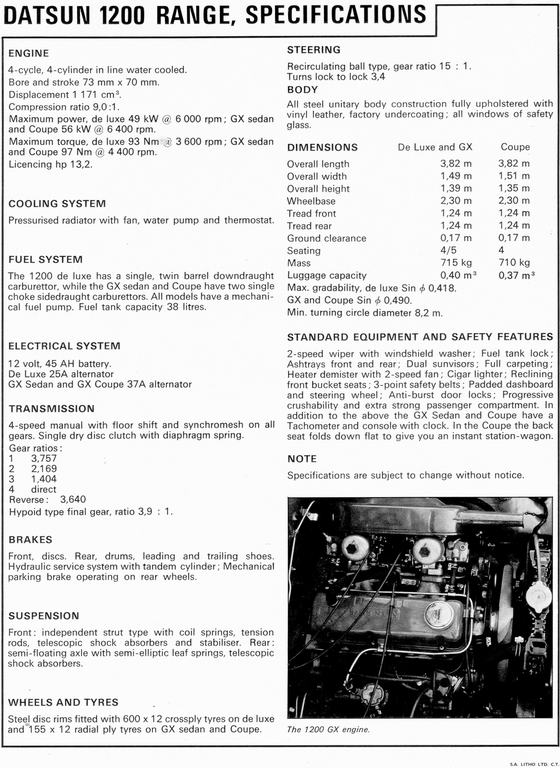
|






![[Datsun 1200 encyclopedia]](/wiki/upload/wiki.png)



